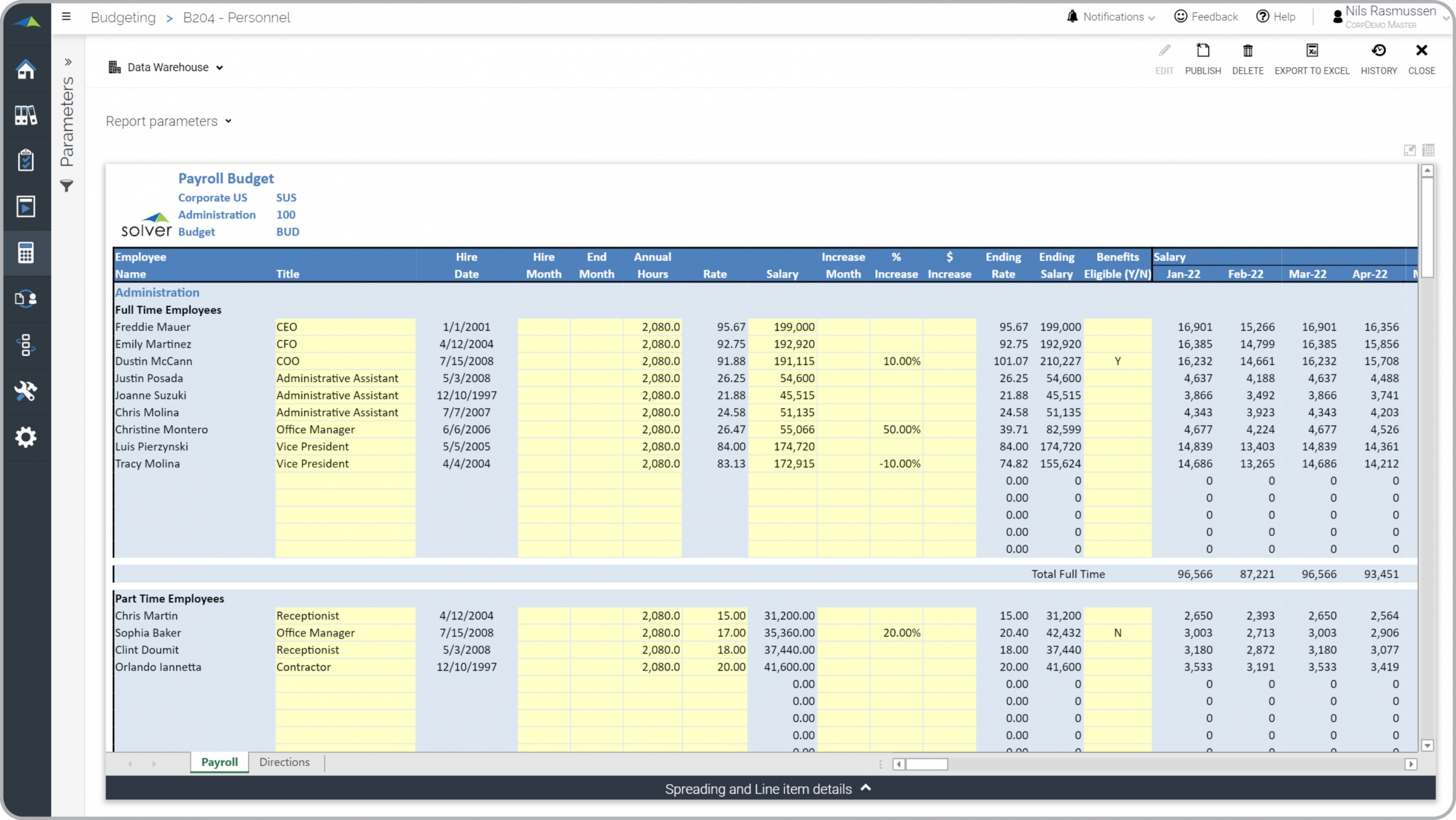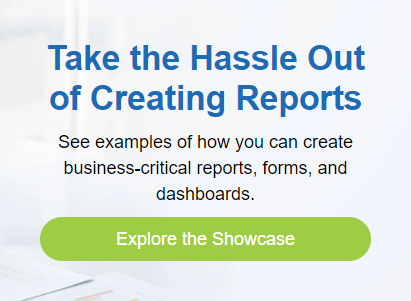High-Impact Ideas
All Examples
Recent Posts
Payroll Budget Template
What is
a
Payroll Budget Template
? Payroll budget input forms are considered a key part of annual budget models and are used by HR and budget managers to develop salary expense and hiring plans. Some key functionality in this type of budget template allows the user to quickly generate departmental employee budgets by entering or adjusting annual salaries for salaried staff, and hours or rates for hourly employees. Along with other options, all the employee-related taxes and benefits are automatically calculated based on assumptions captured on another screen. You will find an example of this type of budget template below.
Purpose of
Payroll Budget Forms Companies and organizations use Payroll Budget Forms to quickly and securely develop a detailed bottom-up annual salary, tax and benefit budget. When used as part of good business practices in Financial Planning & Analysis (FP&A) and HR Departments, a company can improve its hiring and cost decisions related to workforce planning. It can also reduce the risk that it will miss employee expense targets, which can potentially result in a dramatic impact on profitability.
Payroll Budget Form
Example Here is an example of a departmental Payroll Budget form that calculates salaries, taxes and benefits. [caption id="" align="alignnone" width="2560"]
 Payroll Budget Template Example[/caption] You can find hundreds of additional examples
here.
Who Uses This Type of
Budget Template
? The typical users of this type of budget template are: Human Resources (HR) and budget managers.
Other
Budget Template
s Often Used in Conjunction with
Payroll Budget Forms Progressive Financial Planning & Analysis (FP&A) and HR Departments sometimes use several different Payroll Budget Forms, along with budget templates for sales, capital expenses, profit & loss and other management and control tools.
Where Does the Data for Analysis Originate From? The Actual (historical transactions) data typically comes from enterprise resource planning (ERP) systems like: Microsoft Dynamics 365 (D365) Finance, Microsoft Dynamics 365 Business Central (D365 BC), Microsoft Dynamics AX, Microsoft Dynamics NAV, Microsoft Dynamics GP, Microsoft Dynamics SL, Sage Intacct, Sage 100, Sage 300, Sage 500, Sage X3, SAP Business One, SAP ByDesign, Netsuite and others. In analyses where budgets or forecasts are used, the data most often originates from in-house Excel spreadsheet models or from professional corporate performance management (CPM/EPM) solutions.
What Tools are Typically used for Reporting, Planning and Dashboards? Examples of business software used with the data and ERPs mentioned above are:
Payroll Budget Template Example[/caption] You can find hundreds of additional examples
here.
Who Uses This Type of
Budget Template
? The typical users of this type of budget template are: Human Resources (HR) and budget managers.
Other
Budget Template
s Often Used in Conjunction with
Payroll Budget Forms Progressive Financial Planning & Analysis (FP&A) and HR Departments sometimes use several different Payroll Budget Forms, along with budget templates for sales, capital expenses, profit & loss and other management and control tools.
Where Does the Data for Analysis Originate From? The Actual (historical transactions) data typically comes from enterprise resource planning (ERP) systems like: Microsoft Dynamics 365 (D365) Finance, Microsoft Dynamics 365 Business Central (D365 BC), Microsoft Dynamics AX, Microsoft Dynamics NAV, Microsoft Dynamics GP, Microsoft Dynamics SL, Sage Intacct, Sage 100, Sage 300, Sage 500, Sage X3, SAP Business One, SAP ByDesign, Netsuite and others. In analyses where budgets or forecasts are used, the data most often originates from in-house Excel spreadsheet models or from professional corporate performance management (CPM/EPM) solutions.
What Tools are Typically used for Reporting, Planning and Dashboards? Examples of business software used with the data and ERPs mentioned above are:
 Payroll Budget Template Example[/caption] You can find hundreds of additional examples
here.
Who Uses This Type of
Budget Template
? The typical users of this type of budget template are: Human Resources (HR) and budget managers.
Other
Budget Template
s Often Used in Conjunction with
Payroll Budget Forms Progressive Financial Planning & Analysis (FP&A) and HR Departments sometimes use several different Payroll Budget Forms, along with budget templates for sales, capital expenses, profit & loss and other management and control tools.
Where Does the Data for Analysis Originate From? The Actual (historical transactions) data typically comes from enterprise resource planning (ERP) systems like: Microsoft Dynamics 365 (D365) Finance, Microsoft Dynamics 365 Business Central (D365 BC), Microsoft Dynamics AX, Microsoft Dynamics NAV, Microsoft Dynamics GP, Microsoft Dynamics SL, Sage Intacct, Sage 100, Sage 300, Sage 500, Sage X3, SAP Business One, SAP ByDesign, Netsuite and others. In analyses where budgets or forecasts are used, the data most often originates from in-house Excel spreadsheet models or from professional corporate performance management (CPM/EPM) solutions.
What Tools are Typically used for Reporting, Planning and Dashboards? Examples of business software used with the data and ERPs mentioned above are:
Payroll Budget Template Example[/caption] You can find hundreds of additional examples
here.
Who Uses This Type of
Budget Template
? The typical users of this type of budget template are: Human Resources (HR) and budget managers.
Other
Budget Template
s Often Used in Conjunction with
Payroll Budget Forms Progressive Financial Planning & Analysis (FP&A) and HR Departments sometimes use several different Payroll Budget Forms, along with budget templates for sales, capital expenses, profit & loss and other management and control tools.
Where Does the Data for Analysis Originate From? The Actual (historical transactions) data typically comes from enterprise resource planning (ERP) systems like: Microsoft Dynamics 365 (D365) Finance, Microsoft Dynamics 365 Business Central (D365 BC), Microsoft Dynamics AX, Microsoft Dynamics NAV, Microsoft Dynamics GP, Microsoft Dynamics SL, Sage Intacct, Sage 100, Sage 300, Sage 500, Sage X3, SAP Business One, SAP ByDesign, Netsuite and others. In analyses where budgets or forecasts are used, the data most often originates from in-house Excel spreadsheet models or from professional corporate performance management (CPM/EPM) solutions.
What Tools are Typically used for Reporting, Planning and Dashboards? Examples of business software used with the data and ERPs mentioned above are:
- Native ERP report writers and query tools
- Spreadsheets (for example Microsoft Excel)
- Corporate Performance Management (CPM) tools (for example Solver)
- Dashboards (for example Microsoft Power BI and Tableau)
- View 100’s of reporting, consolidations, planning, budgeting, forecasting and dashboard examples here
- Discover how the Solver CPM solution delivers financial and operational reporting
- Discover how the Solver CPM solution delivers planning, budgeting and forecasting
- Watch demo videos of reporting, planning and dashboards
June 26, 2020
Global Headquarters
Solver Suite
Core Subscription
Company and Resources
© Copyright 2024, Solver All rights reserved.LegalPrivacy
QuickStart and Template Marketplace Overview (2 min) |QuickStart and Template Marketplace Setup (10 min)
Global Headquarters
Solver Suite
Core Subscription
Company and Resources
© Copyright 2024, Solver All rights reserved.LegalPrivacy
QuickStart and Template Marketplace Overview (2 min) |QuickStart and Template Marketplace Setup (10 min)
Global Headquarters
Solver Suite
Core Subscription
Company and Resources
© Copyright 2024, Solver All rights reserved.LegalPrivacy
QuickStart and Template Marketplace Overview (2 min) |QuickStart and Template Marketplace Setup (10 min)
Global Headquarters
Solver Suite
Core Subscription
Company and Resources
© Copyright 2024, Solver All rights reserved.LegalPrivacy
QuickStart and Template Marketplace Overview (2 min) |QuickStart and Template Marketplace Setup (10 min)




